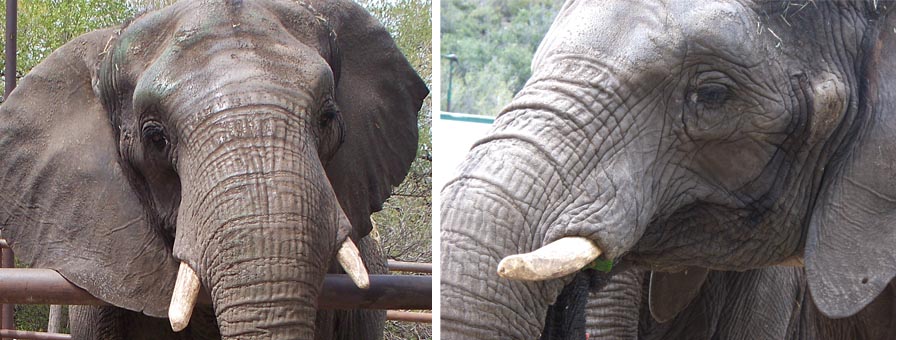

Scientific Phenomena
Scientists know that only some animals are smart enough to know themselves when they look in a mirror. This is called "self-awareness." These animals include humans, some apes and monkeys, and dolphins. Other "less intelligent" animals think that their reflection is another animal in their pack and may act aggressively or friendly toward it. Some are puzzled by the mirror and look behind it. A rare few do things like repeating behaviors in front of the mirror. Only the "self-aware" animals can tell they are looking at themselves.
Now elephants can be added to that group. Researchers at Emory University placed a huge mirror in the elephant enclosure at the Bronx Zoo and have discovered that the elephants could see their reflection as themselves. This was proven when the elephants touched and examined their faces in the mirror, something researchers had never given them the opportunity to do before. Now we know elephants are truly the highly intelligent animals many suspected them to be.
Link to article: https://www.nytimes.com/2006/10/31/science/31observ.html
Essential Questions
1. How does intelligence (displayed by "self-awareness") affect a species ability to adapt to a changing environment and potentially increase their chances for survival and reproduction.
Disciplinary Core Ideas
LS4.C: Adaptation: LINK
Adaptation by natural selection acting over generations is one important process by which species change over time in response to changes in environmental conditions. Traits that support successful survival and reproduction in the new environment become more common; those that do not become less common. Thus, the distribution of traits in a population changes. (MS-LS4-6)
Science and Engineering Practices
Analyzing and Interpreting Data: Analyze and interpret data to determine similarities and differences in findings.
Constructing Explanations and Designing Solutions: Apply scientific ideas to construct an explanation for real-world phenomena, examples, or events.
Obtaining, Evaluating, and Communicating Information: Gather, read, and synthesize information from multiple appropriate sources and assess the credibility, accuracy, and possible bias of each publication and methods used, and describe how they are supported or not supported by evidence.
Crosscutting Concepts
Patterns: Patterns can be used to identify cause and effect relationships
Cause and Effect: Phenomena may have more than one cause, and some cause and effect relationships in systems can only be described using probability.
Other questions that were generated in researching this Scientific Phenomena?
______________________________________________________________________________
Using Discoveries and Inventions as Scientific Phenomena to Integrate with NGSS:
______________________________________________________________________________
Scientific Phenomena can be used as a tool to anchor a science unit involving a series of lessons to engage in deeper science learning – or what is being called “Three Dimensional Learning”.
1) Describe the phenomena in a way that your students can understand and which sparks their imagination.
2) Create Essential Questions for them to answer to explain the phenomena.
3) Identify the NGSS Disciplinary Core Ideas which you are targeting.
4) Provide clear directions for a process they should use to try to answer the questions using the NGSS Science and Engineering Practices to frame as your guideline.
Provide a few links online to get them started obtaining information.
Once they find some sources, they should evaluate them and communicate their findings to the rest of the class.
Practice analyzing and interpreting the data they find.
5) Name the Crosscutting Concepts that students should be aware of throughout the lesson.
Then suggest ways that they can identify patterns, cause and effect, etc.
6) Make note of other questions generated in the process of exploring this Scientific Phenomena. Discuss them as a class.
